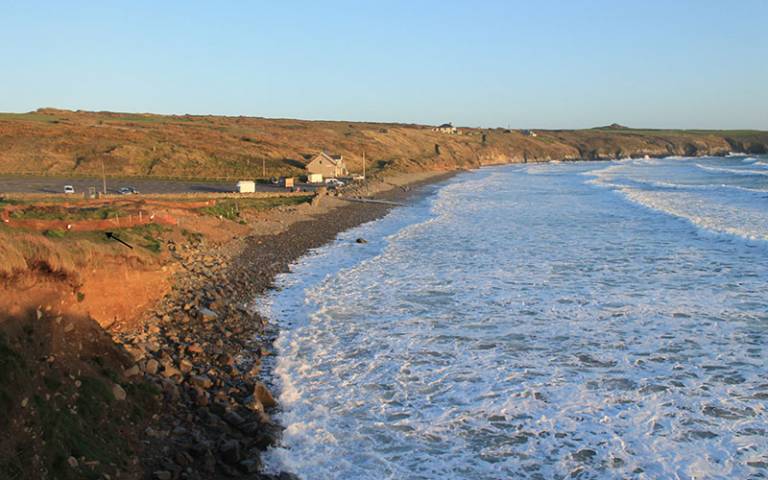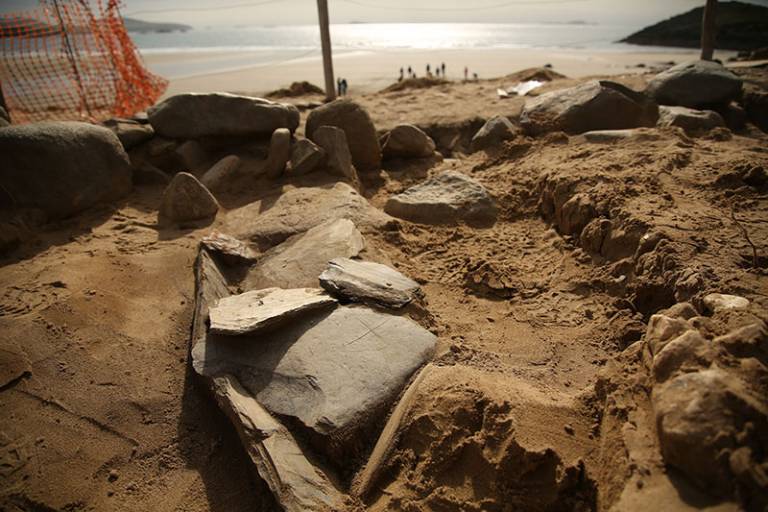Investigating the lives of those who lived and died in Pembrokeshire during the early medieval period.

Immediately north of Traeth Mawr (Whitesands Bay) in the parish of St Davids, Pembrokeshire is a mound of wind-blown sand and a strip of rough ground known as Parc y Capel (Chapel Field). Beneath this mound is St Patrick’s Chapel and an associated early medieval cemetery.
The site was known historically and previous excavations took place in the 20th century; in 1924, excavation by Badger and Green revealed the walls of a small, stone-built chapel. The site’s location on the edge of the dunes means it is particularly vulnerable to coastal erosion, and the severe storms of 2013-14 exposed a number of burials on the seaward-edge. As such, the decision was made to excavate this important, yet vulnerable, site.
With financial support from Cadw and the EU, and an army of volunteers, excavation has taken place at the site since 2014 as part of a collaborative project between Katie Hemer (UCL Institute of Archaeology), Dyfed Archaeological Trust, and the Pembrokeshire Coast National Park Authority.
Beneath the later medieval chapel is a substantial early medieval cemetery dating from the 8th-12th centuries AD; it represents one of the largest burial sites of this period with over 200 burials excavated to date. In keeping with Christian tradition, no grave goods were used, and most burials were aligned east-west (head to the west). Burials include stone-lined cists and occasionally cross-incised grave markers. The population consists of men, women and children - a significant number of whom died very young. Ongoing bioarchaeological analyses of the skeletal remains includes osteology, stable isotope analysis, and aDNA analysis; the aim is to explore questions about kinship, migration, diet, health, and disease. Doing so will help us to better understand the lives of those who lived and died in Pembrokeshire during the early medieval period.

Related outputs
Publications
- Hemer, K.A., Verlinden, P. (2020). Vitamin D Deficiency Rickets in Early Medieval Wales: Multi-Methodological Case Study. Childhood in the Past 13:1: 20-37.
- Shiner, M., Hemer, K.A. and Commeau, R. 2019. The St Patrick’s Chapel Excavation Project: Public Engagement with the Rescue Excavation of an Early Medieval Cemetery in South West Wales. In, Williams, H., Wills-Evev, B. and Osborne, J (eds). The Public Archaeology of Death. Equinox Publishing, Sheffield.
- Hemer, K.A., Lamb, A.L., Chenery, C.A., and Evans, J.A. 2017. A multi-isotope investigation of diet in early medieval western Britain. American Journal of Physical Anthropology 162: 423-440.
Invited talks
- QUB, 2022. ‘Down by the seaside: Excavation of the early medieval cemetery beneath St Patrick's Chapel, Pembrokeshire’.
- Oxford, 2021. Secrets in the Sand: Recent Excavations at St Patrick's Chapel, Pembrokeshire.
- UCL, 2015. ‘On the utmost border of the earth’: life and death in early medieval Wales. UCL Institute of Archaeology / British Museum Medieval Seminar Series, London.
Conferences
- 2018. Concern for the living, care for the dead: non-adult burial at the early Christian cemetery of St Patrick’s Chapel, Pembrokeshire. Society for American Archaeology 83rd Annual Meeting, Washington. (co-authored with Dr Marion Shiner, University of Sheffield).
- 2017. Hemer, K.A., Verlinden, P., Murphy, K., Shiner, M. 2017. A bioarchaeological investigation of the early medieval cemetery of St Patrick’s Chapel, Pembrokeshire. UK Archaeological Science Conference UCL, London. (Poster presentation - Awarded Early Career Researcher Poster Prize by the Society for Archaeological Science).
- 2017. A bioarchaeological study of the early medieval cemetery below St Patrick’s Chapel, Pembrokeshire. Early medieval Wales Archaeology Research Group, Bangor.
- 2015. St Patrick’s Chapel Cemetery. Bioarchaeological analyses: Preliminary Results. ‘Early Medieval Wales Archaeology Research Group, Welshpool’.
Public engagement activities
- An extensive programme of public engagement activities around the St Patrick’s Chapel Excavation Project have taken place since 2015. This includes the recruitment of local volunteers to assist with the excavation of the site since 2014.
- Bilingual (Welsh-English) tours of the excavation have been run for members of the public visiting the site since 2015.
- A bilingual film of the 2015 excavation was produced professionally and made available on YouTube.
- A temporary exhibition in St David’s Cathedral was in place throughout August and September 2015; over 79,000 members of the public are said to have visited the Cathedral and the exhibition during this period.
- The project featured in the annual 2016 issue of the Pembrokeshire Coast National Park Authority’s magazine, ‘Coast to Coast’. Over 235,000 print copies were distributed to 500 outlets across Pembrokeshire and was available online and through the PCNPA app.
Media (TV) appearances
- ‘Digging for Britain’, BBC, 2021
- ‘Cynefin’, S4C, 2019
- ‘Digging for Britain’, BBC, 2016
Funding
- University of Sheffield ‘Innovation, Impact and Knowledge Exchange Collaborative Research & Design Award’
- Nineveh Charitable Trust
- European Regional Development Fund (part of the ‘Ancient Connections’ project)
 Close
Close

